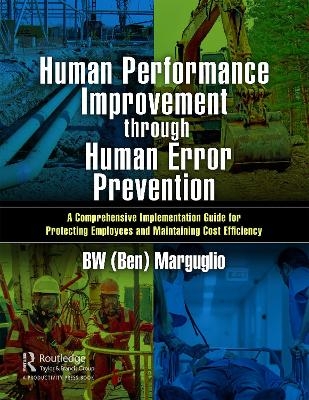
Human Performance Improvement through Human Error Prevention
CRC Press (Verlag)
978-0-367-67239-3 (ISBN)
This book is a simulation of a live course on human performance improvement/human error prevention (HPI/HEP) created by the preeminent authority on HPI/HEP. It presents the greatest breadth of scope and specificity on this topic. This book comprises a focused, challenging human error prevention training course designed to improve understanding of error causation. It will dramatically reduce human error and repeat deviations, and it digs below the surface of issues and looks to fix the real causes of human error and mistakes.
In addition, this book presents a complete seminar from the thought leader acclaimed by hundreds of clients, and includes unique principles, practices, models, and templates. Information is comprehensive and can be directly implemented. The principles and practices of human error prevention are universally applicable regardless of the type of industrial, commercial, or governmental enterprise, and regardless of the type of function performed within the enterprise. The application of the information in this book will significantly contribute to improved productivity, safety, and quality.
After fully using this book, you will understand:
Human error prevention/reduction terminology and definitions.
The relationships among culture, beliefs, values, attitudes, behavior, results, and performance.
The roles of leadership in establishing and maintaining a quality/safety-conscious work environment.
The one fundamental precept explaining the importance of human error prevention/reduction.
The two most critical elements of human error prevention/reduction.
The three levels of barriers to human error.
The four types of things in which the barriers may exist at each barrier level.
The five stages of human error.
The six "M"s that can emit or receive hazards activated by human error.
The seven universally applicable human error causal factors.
The Rule of 8 by which to prevent human error and mitigate its effects.
Techniques for making barriers effective and the spectrum of barrier effectiveness.
The relationship of human error prevention/reduction to the total quality/safety function.
Error-inducing conditions (error traps) and behaviors for counteracting these conditions.
Non-conservative and conservative thought processes and behaviors in decision-making.
Coaching for preventing the recurrence of human error.
Root cause analysis techniques for identifying human error causal factors.
The nine types of corrective action.
Human error measurement.
Strategies for a human error prevention/reduction initiative.
How to design, implement, and manage a human error prevention/reduction initiative.
Ben Marguglio is a management and technical consultant with decades of experience in high technology enterprises, and was previously a corporate executive with positions at Aerojet Nuclear Company and Consumers Power Company. He is a former management team leader for multi-million-dollar design and construction projects and management team member for a multi-billion-dollar design and construction project. Ben is a preeminent subject matter expert on: • Human performance improvement / human error prevention / human factors. • Process, component and facility risk management (hazard identification, risk assessment and risk treatment). • Problem / incident / failure investigation, root cause analysis and corrective action. • Management systems – including systems for project management; design engineering; procurement; fabrication, assembly, construction and installation; maintenance; and operations – with considerations for the quality of production, of safety and health, of environmental protection, security, and emergency preparedness and response. Ben has served as a fellow of the American Society for Quality (ASQ) since 1973 and is a ASQ Certified Quality Engineer, Reliability Engineer, Quality Auditor, and Manager of Quality / Organizational Excellence.
1 Major Learning Objectives
2 Introduction
3 1st Field of Focus: Hazards and Barriers
4 2nd Field of Focus: Error-Inducing Conditions, Error-Likely Situations and Counteracting Behaviors
5 3rd Field of Focus: Non-Conservative and Conservative Decision-Making Thought Processes and Behaviors
6 4th Field of Focus: Prevention of the Recurrence of Error7 Strategies
Appendix A: Words and Terms Used in the Course
Appendix B: Format and Writing Conventions for a Procedure/Process Description DocumentAppendix C: Types of Contents of a Procedure/Process Description Document
Appendix D: Types of Design Requirements for Hardware Items and a Facility
Appendix E: Elements of a Design Calculations Management System
Appendix F: Elements of a Software/Firmware Management System
Appendix G: Elements of an Inspection and Test Management System
Appendix H: Elements of a Records Management System and Types of Records
Appendix I: Cross-References for a Configuration Management System
| Erscheinungsdatum | 09.06.2021 |
|---|---|
| Zusatzinfo | 105 Line drawings, color; 105 Illustrations, color |
| Verlagsort | London |
| Sprache | englisch |
| Maße | 210 x 280 mm |
| Gewicht | 2140 g |
| Themenwelt | Naturwissenschaften ► Biologie ► Ökologie / Naturschutz |
| Technik ► Umwelttechnik / Biotechnologie | |
| Wirtschaft ► Betriebswirtschaft / Management ► Logistik / Produktion | |
| Wirtschaft ► Betriebswirtschaft / Management ► Rechnungswesen / Bilanzen | |
| Betriebswirtschaft / Management ► Spezielle Betriebswirtschaftslehre ► Immobilienwirtschaft | |
| ISBN-10 | 0-367-67239-1 / 0367672391 |
| ISBN-13 | 978-0-367-67239-3 / 9780367672393 |
| Zustand | Neuware |
| Informationen gemäß Produktsicherheitsverordnung (GPSR) | |
| Haben Sie eine Frage zum Produkt? |
aus dem Bereich


